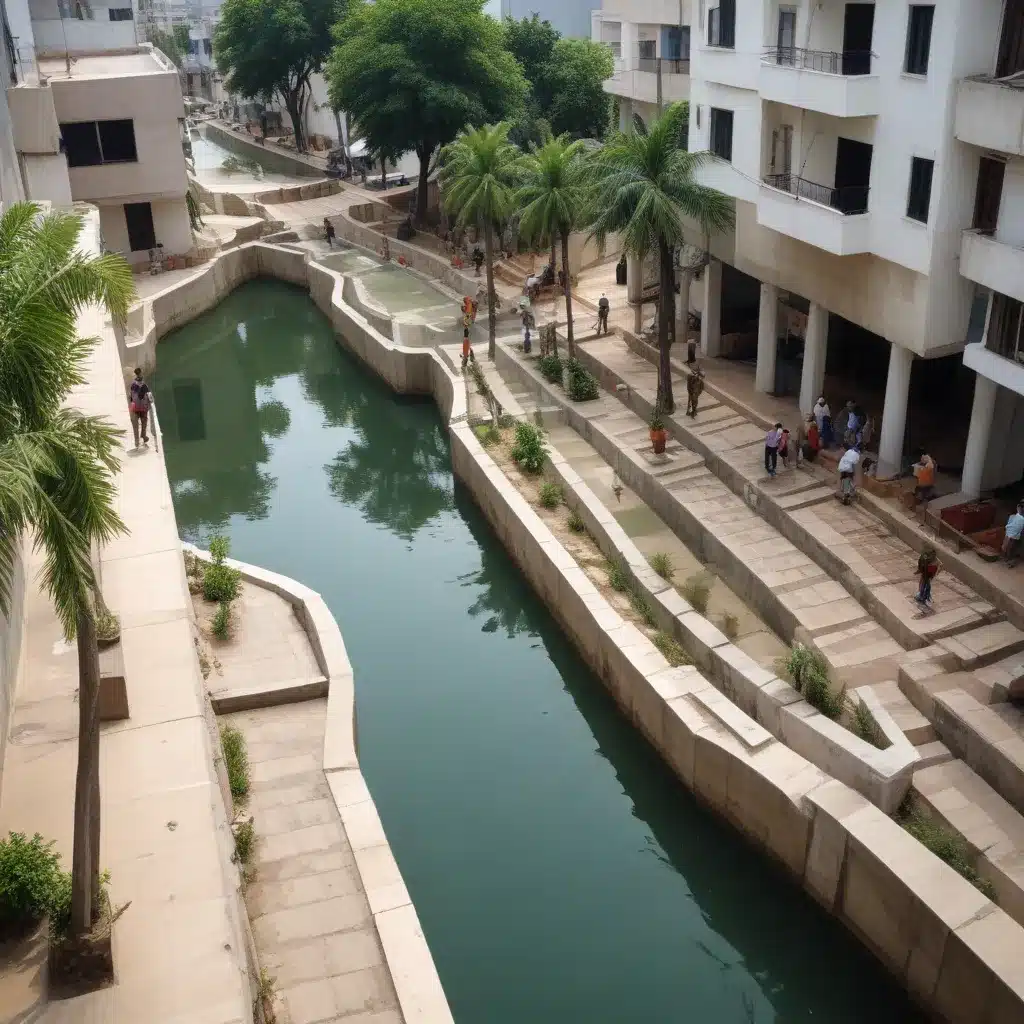
The Urgent Need for a Water-Sensitive Transformation
As cities around the world grapple with the challenges of population growth, economic development, and the looming threats of climate change, the city of Hyderabad stands at a critical juncture. Situated along the banks of the Musi River in south-central India, Hyderabad is no stranger to water-related challenges – from recurring droughts and water scarcity to periodic urban flooding. However, the city’s current approach to water management, rooted in traditional infrastructure-driven solutions, is proving increasingly inadequate in the face of these complex, interconnected issues.
It is time for Hyderabad to embrace a new paradigm – one that places water at the heart of urban design and planning. This transition towards a water-sensitive city holds the key to building resilience, enhancing liveability, and ensuring sustainable water futures for the rapidly growing metropolis.
Unlocking the Potential of Water-Sensitive Urban Design
Water-sensitive urban design (WSUD) is a holistic approach that integrates the management of the urban water cycle – including water supply, wastewater, stormwater, and groundwater – into the design and planning of the built environment. It moves beyond the traditional, siloed management of water resources and instead promotes a systems-based understanding of the urban water cycle.
By adopting WSUD principles, cities like Hyderabad can unlock a range of benefits:
-
Improved Water Security: WSUD strategies, such as rainwater harvesting, stormwater management, and managed aquifer recharge, can enhance the city’s ability to capture, store, and reuse water, reducing reliance on external sources and improving water self-sufficiency.
-
Reduced Flood Risks: Integrating green infrastructure, permeable surfaces, and decentralized stormwater management systems can help mitigate urban flooding, a persistent challenge in Hyderabad during the monsoon season.
-
Enhanced Liveability: WSUD can transform the urban landscape, creating multifunctional blue-green spaces that provide recreational opportunities, urban cooling, and improved aesthetics – all of which contribute to the overall quality of life for Hyderabad’s residents.
-
Ecosystem Restoration: By reconnecting the city to its natural water bodies and promoting the integration of natural systems, WSUD can help restore the ecological health of the Musi River and its associated wetlands, benefiting both biodiversity and human well-being.
-
Climate Resilience: As Hyderabad grapples with the impacts of climate change, including more frequent and intense extreme weather events, WSUD strategies can enhance the city’s ability to adapt and withstand these challenges.
Charting the Transition: Strategies for Hyderabad
Transitioning Hyderabad towards a water-sensitive city will require a multifaceted approach, encompassing policy reforms, institutional coordination, community engagement, and strategic investments. Here are some key strategies to consider:
Policy and Governance Reforms
- Integrate WSUD principles into city master plans and development guidelines: Ensure that all new urban development projects and infrastructure investments incorporate WSUD elements from the planning stage.
- Establish a dedicated Water-Sensitive Urban Design Cell: Create a specialized unit within the municipal government to coordinate, monitor, and champion the implementation of WSUD across different departments and stakeholders.
- Incentivize WSUD adoption: Explore mechanisms such as tax rebates, subsidies, or expedited permitting processes to encourage private property owners and developers to implement WSUD measures on their premises.
Institutional Collaboration and Capacity Building
- Foster cross-departmental coordination: Establish formal mechanisms for collaboration between the water, urban planning, environment, and disaster management departments to ensure a holistic, integrated approach to water management.
- Engage with academic and research institutions: Partner with local universities, research centers, and think tanks to conduct pilot projects, develop innovative WSUD solutions, and build the technical capacity of municipal staff.
- Strengthen community engagement: Actively involve residents, community-based organizations, and local businesses in the planning and implementation of WSUD initiatives, ensuring a sense of ownership and commitment to the transition.
Financing and Implementation
- Explore alternative financing models: Utilize a combination of public funding, private investments, and innovative mechanisms such as green bonds or water tariff reforms to finance WSUD projects.
- Prioritize nature-based solutions: Prioritize the use of green infrastructure, such as wetlands, urban forests, and permeable surfaces, which can provide multiple ecosystem services while being more cost-effective than traditional gray infrastructure.
- Pilot and scale WSUD demonstration projects: Implement high-visibility WSUD showcases in strategic locations to raise awareness, build community support, and demonstrate the benefits of this approach.
Lessons from Global Frontrunners: Inspiration for Hyderabad
As Hyderabad embarks on its water-sensitive transformation, it can draw inspiration from the experiences of other cities around the world that have successfully adopted WSUD principles.
https://jointactionforwater.org/ highlights the examples of cities like Copenhagen, Rotterdam, and Hamburg, which have made significant strides in integrating blue-green infrastructure into their urban landscapes. These cities have not only enhanced their resilience to water-related challenges but have also transformed their public spaces into vibrant, liveable environments.
Similarly, the city of Newcastle in the United Kingdom has implemented innovative WSUD strategies, such as the use of permeable paving and bioretention systems, to manage stormwater and mitigate urban flooding. These examples demonstrate the tangible benefits that can be achieved through a holistic, water-centric approach to urban design and planning.
Embracing a Water-Sensitive Future for Hyderabad
The path towards a water-sensitive Hyderabad may not be without its challenges, but the potential rewards are immense. By embracing the principles of water-sensitive urban design, the city can chart a course towards a more resilient, liveable, and sustainable future – one that places water at the heart of its urban transformation.
Through a collaborative effort involving policymakers, urban planners, water professionals, researchers, and engaged citizens, Hyderabad can unlock the power of WSUD to address its pressing water-related challenges, improve the quality of life for its residents, and become a shining example of water-sensitive urbanism in India and beyond.
The time for action is now. By harnessing the transformative potential of water-sensitive urban design, Hyderabad can secure its water future, build resilience, and shape a more prosperous, equitable, and liveable city for generations to come.

